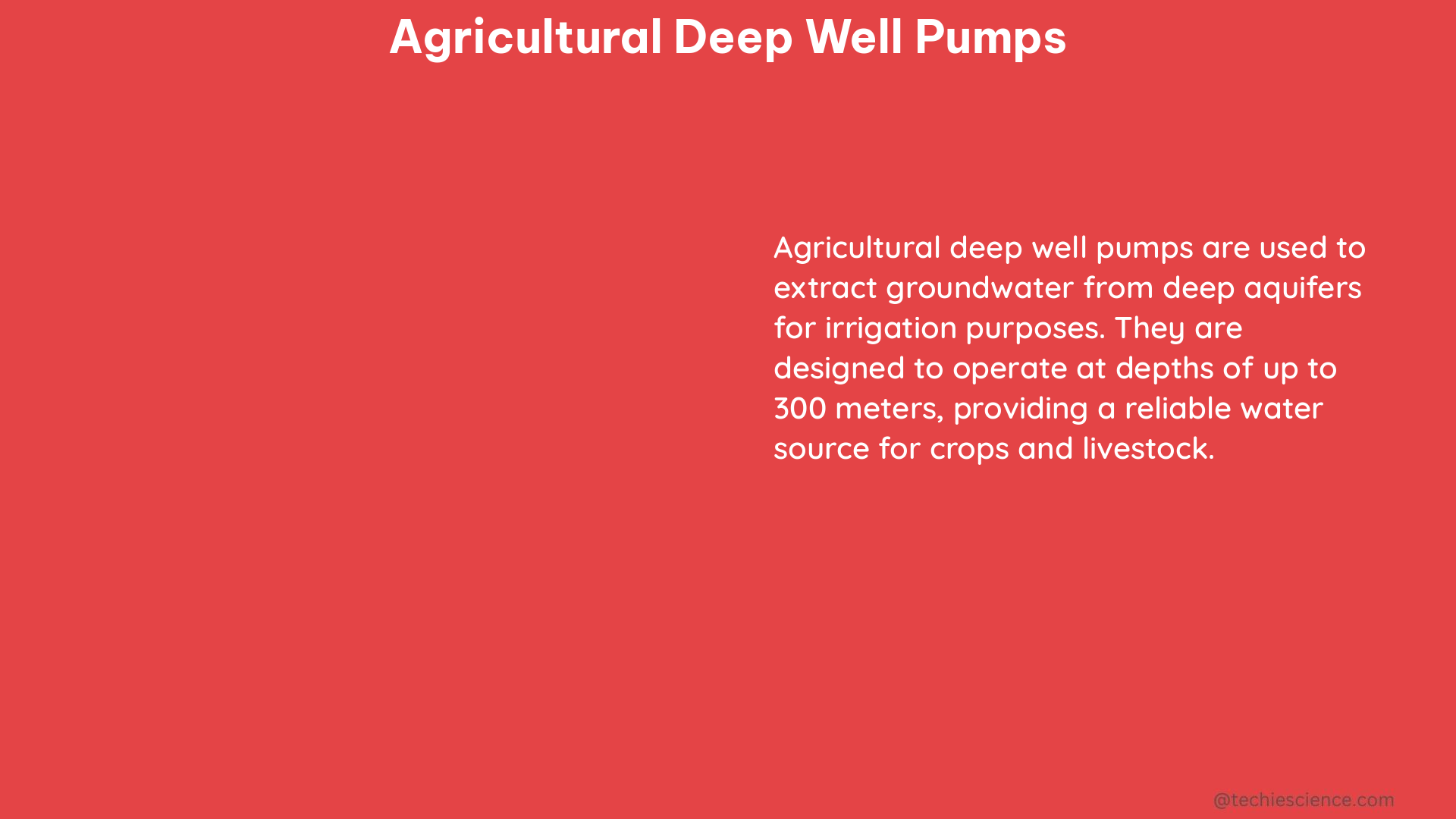Agricultural deep well pumps are essential for irrigation and water management in farming, particularly in regions with limited surface water availability and increasing reliance on groundwater pumping. These pumps are designed to extract water from significant depths, often hundreds of feet below the surface, to meet the agricultural sector’s water needs.
Understanding the Technical Specifications of Agricultural Deep Well Pumps
The technical specifications of agricultural deep well pumps can vary widely, depending on the specific requirements of the farming operation. Let’s explore the key details of a solar-powered water pump system designed for stockwater in North Dakota:
Well Depth and Water Levels
- The well depth is 285 feet below the surface.
- The static water level is 190 feet below the surface.
- The dynamic water level is 70 feet below the surface after 2 hours of pumping at 10 gallons per minute (gpm).
Pump Depth
- The pump is located 275 feet below the surface.
Water Requirement
- The system is designed to provide 1,000 gallons of water per day for 50 cow/calf pairs, with each animal requiring 20 gallons of water per day.
System Layout
- The storage tank, pump, and photovoltaic (PV) panels are located in close proximity to minimize electric power and pipeline friction losses.
- The storage tank is positioned at a higher elevation than the water troughs, allowing for gravity-fed water flow.
Solar Insolation and Solar Array Layout
- The solar insolation values for the project site are obtained from the NDAWN station near Hazen, ND.
- The system is designed to accommodate grazing activities, ensuring the pipe size, flow rate, length, and pipe roughness are suitable for the application.
Factors Influencing the Selection of Agricultural Deep Well Pumps

When choosing an agricultural deep well pump, several factors must be considered to ensure optimal performance and efficiency:
-
Pump Type: The selection of the pump type, such as submersible, jet, or centrifugal, depends on the well depth, water flow requirements, and energy source (electric, diesel, or solar).
-
Pump Capacity: The pump capacity, measured in gallons per minute (gpm), must be sufficient to meet the water demand for irrigation, livestock, or other agricultural needs.
-
Pump Efficiency: The pump’s efficiency, which is the ratio of the power output to the power input, is crucial for minimizing energy consumption and operating costs.
-
Energy Source: The energy source, whether it’s electricity, diesel, or solar power, will determine the pump’s power requirements and the overall system design.
-
Well Characteristics: The well depth, water table depth, and aquifer properties, such as permeability and transmissivity, will influence the pump’s selection and installation.
-
Environmental Factors: Factors like ambient temperature, humidity, and the presence of corrosive or abrasive materials in the water can affect the pump’s durability and lifespan.
-
Regulatory Compliance: Depending on the location, there may be specific regulations or guidelines regarding the installation and operation of agricultural deep well pumps, which must be taken into account.
Optimizing the Performance of Agricultural Deep Well Pumps
To ensure the optimal performance and efficiency of agricultural deep well pumps, several strategies can be employed:
-
Proper Pump Sizing: Accurately sizing the pump based on the water demand, well characteristics, and energy source is crucial to avoid over- or under-sizing, which can lead to inefficient operation and higher energy costs.
-
Maintenance and Monitoring: Regular maintenance, such as cleaning the pump and well, checking for wear and tear, and monitoring the pump’s performance, can help extend the pump’s lifespan and maintain optimal efficiency.
-
Energy Efficiency Measures: Implementing energy-efficient technologies, such as variable-frequency drives (VFDs) or solar-powered systems, can significantly reduce the energy consumption and operating costs of agricultural deep well pumps.
-
Demand Management: Strategies like precision irrigation, crop selection, and water conservation can help manage the water demand and reduce the overall energy requirements of the agricultural deep well pump system.
-
Grid Integration and Load Management: Exploring the potential for load management technologies and demand response programs can help mitigate the impact of agricultural deep well pumps on the electrical grid, providing co-benefits to both the agricultural industry and the grid.
Conclusion
Agricultural deep well pumps play a vital role in the agricultural sector, enabling efficient water management and irrigation in areas with limited surface water resources. By understanding the technical specifications, factors influencing pump selection, and strategies for optimizing performance, farmers and agricultural professionals can ensure the effective and sustainable use of these critical water infrastructure assets.
References:
- Deep Well Pump Market Research 2024-2032
- Agricultural Water-Energy Nexus
- Precision Irrigation and Demand Response
- Metering Agricultural Pumping at Numerous Small-Scale Farms
- Solar-Powered Water Pump Systems for Stockwater Design

The lambdageeks.com Core SME Team is a group of experienced subject matter experts from diverse scientific and technical fields including Physics, Chemistry, Technology,Electronics & Electrical Engineering, Automotive, Mechanical Engineering. Our team collaborates to create high-quality, well-researched articles on a wide range of science and technology topics for the lambdageeks.com website.
All Our Senior SME are having more than 7 Years of experience in the respective fields . They are either Working Industry Professionals or assocaited With different Universities. Refer Our Authors Page to get to know About our Core SMEs.